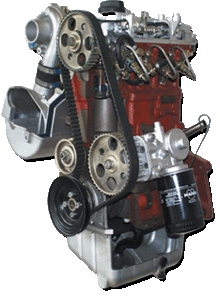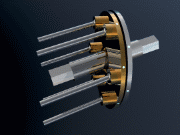Elsbett engine
An Elsbett engine is a multi-fuel reciprocating piston engine that works on the diesel principle . The characteristic feature is the combustion of the injected fuel in the combustion air rotating in the piston chamber. The air flowing close to the wall should not take part in the combustion in order to keep the heat emission low. The principle can be used regardless of the design and working method of the engines. The motors can be operated with low cooling losses .
The term Elsbett-Motor goes back to the name of its inventor Ludwig Elsbett .
history
The origins of the Elsbett engines lie in 1937 with the Junkers aircraft works . The last diesel two-stroke opposed piston engine developed by Ludwig Elsbett resembles the first developments he worked on. The Junkers Jumo 205 already worked according to this principle, which led to a high degree of efficiency in the Jumo 207 .
Between 1973 and 1978 three-cylinder in- line engines and six-cylinder V-engines were produced. A prototype of a 14-cylinder swash plate motor according to the principle of the swash plate machine was built, but never used.
For agriculture, the “Eicher 3108 Elsbett (3026 / ZF T3345)” tractor with 96 kW (130 PS) was presented at Agritechnica in 1989 . The starting point was an Eicher three-cylinder EDL engine. A displacement of 3890 cm³ was achieved with larger cylinders. The maximum torque was 430 Nm at 1500 min -1 , a torque increase of 29 percent. The efficiency was 40 percent. The engine had an oil cooler . As the agricultural machinery manufacturer Eicher ran into economic difficulties a short time later, this tractor was unsuccessful. Some components of Elsbett's inventions have recently been taken up again by the tractor manufacturer Deutz-Fahr .
A great future was predicted for the Elsbett engine in the 1980s, as it had a consumption advantage of 20 to 25 percent compared to the diesel engines of the passenger car at the time. It no longer has any advantages over modern diesel engines with direct injection, also in cars, map-controlled multi-stage or multiple injection and turbocharging with charge air cooling .
The higher production price compared to conventional motors can be regarded as the reason for its low distribution. The external patent situation may also have played a role for many corporations.
Some of Elsbett's unfortunate decisions may also have had a negative impact on success.
Thanks to the cooperation with the then Antriebs- und Maschinentechnik GmbH in Schönebeck , Elsbett motors were manufactured there under license and special versions for stationary operation ( CHP ) were further developed. The Junkers Flugzeug- und Motorenwerke already built engines in Schönebeck, and the current developments (2008) by Golle Motor AG are technically linked to the development of the Junkers aircraft engines in which Elsbett was involved.
technology

1) Inlet area (inlet slots)
2) Cooling area of the working space
3) Outlet area (outlet slots)
4) Cooling area of the outlet
The main feature of Elsbett engines is the technical design of the engine in order to use the energy released by the fuel during the combustion process with greater efficiency than with conventional engines. To this end, the Elsbett engine has been improved in the following areas, among others:
Characteristic for the Elsbett engine are the articulated piston with combustion chamber, the rotary flushing and the multi-substance suitability , which was realized by a so-called "non-wall-distributing" injection process. For this purpose, the fuel is injected into the compression chamber in such a way that the surrounding walls (patent graphic cylinder head, cylinder wall and piston crown) are not wetted (comparison: center-ball motor ). This reduces heat loss and prevents the engine from coking. That is why almost all diesel-like fuels, including high- viscosity vegetable oils , can be used.
"Duothermal combustion" is used as a term to describe the effect of Elsbett engines. The Duotherm process and the double Duotherm process can be found in various publications. The aim of this application is to optimize combustion, the problems of which are described in the following articles:
The theories explained in the preceding articles assume a uniform distribution of the combustion air ratio in the combustion chamber (cylinder). Fuel losses due to precipitation on the combustion chamber chamber surfaces are not taken into account. Engines based on the diesel principle are primarily operated with a qualitative mixture regulation - with excess air . For diesel engines, an optimum (λ = lambda) with a lean mixture (excess air) of 1.3 <λ <2.2 was determined. These values are achieved in the core of the combustion by duothermal combustion, whereby the waste heat is used to heat the outer jacket of the gas core, which is not involved in the combustion. The proportion of nitrogen oxides (NO x ) is counteracted in that only the gas components involved in the combustion core reach temperatures in order to form them (see NO x synthesis ). For this purpose, the supply channels for the combustion air are arranged so that it rotates in the combustion chamber. Because the gases approach the center of rotation , the speed of rotation increases . The combustion is ignited in the core of the rotating combustion air. The rotation of the combustion air causes the heavier, cold layers of the unburned air to envelop the core of burned gases. The injection into the rotating gas mass in the hemispherical piston combustion chamber causes a relatively slow, even combustion compared to regular gasoline and diesel engines. No water cooling is required for the Elsbett motor due to its design and high degree of efficiency ; a small oil cooler is sufficient to dissipate the lost heat. Oil from the crankcase is injected from below into the piston on the cylinder for cooling purposes. Elsbett engines were built as reciprocating piston engines with working methods as two-stroke engines and four-stroke engines.
The emission behavior of the Elsbett engines was examined , among other things, in a study on "vegetable oil-powered combined heat and power plants" by the Bavarian State Ministry for Regional Development and Environmental Issues (StMLU).
advantages
- Due to the lack of flame contact with the combustion chamber and cylinder walls, only low heat losses through the walls, which makes their cooling superfluous
- Good efficiency, but not much higher than with modern direct injection
- Long service life due to less load on the motor and low speeds
- In principle suitable for many topics
- Quieter running than diesel engine
disadvantage
- Poor mass / performance ratio; this makes powerful engines very heavy
- Cold start problematic
- Low speed dynamics
- When rapeseed oil is burned, according to the study "Ecobalance rapeseed oil" by the Federal Environment Agency (UBA) in 1992, it was found that motor vehicle fuel made from rapeseed oil has no ecological advantages over fuels based on crude oil. Burning bio-diesel produces 10% more harmful aldehydes and 10% more nitrogen oxides. In a laboratory test with bacteria in mid-2006, researchers at the Federal Research Center for Agriculture in Braunschweig found that rapeseed oil exhaust gases have a ten times higher risk of cancer than fossil diesel.
The above study relates to the combustion of “bio-diesel”, but Ludwig Elsbett used pure vegetable oil in his engine. He also looked for plants with higher oil content than rapeseed.
Demarcation
The technology of Elsbett engines relates to engines based on the diesel principle. Highly volatile fuels, which are described when using flexible fuel vehicle technology, are excluded.
Patent information
- Overview of the Elsbett patents
- Patent DE889959 : Patent specification centrifugal compressor . Published on September 14, 1953 , inventor: Ludwig Elsbett.
- Patent DE1026574 : internal combustion engine, e.g. B. two-stroke injection engine. Published on March 20, 1958 , inventor: Ludwig Elsbett.
- Patent DE1526321 : four-stroke reciprocating internal combustion engine. Published on July 9, 1970 , inventor: Ludwig Elsbett.
- Patent DE3343677 : Reduction of heat and pollutant emissions from diesel engines. Published on June 13, 1985 , inventor: Ludwig Elsbett.
See also
- BtL fuel (fuel made from biomass)
- CtL fuel (Coal to Liquid)
- GtL fuel Liquid fuel production from (natural) gas
- Coal liquefaction
- Biogas
- Biodiesel
- Cellulosic ethanol
- Homogeneous Compression Ignition (HCCI)
literature
- L. Elsbett: The ELSBETT engine . In Motortechnische Zeitschrift (MTZ) , No. 9, 1956 ( PDF file )
- Elsbett auxiliary engine (1-cylinder, 2-stroke), technical description PDF file
- Bernd Hercksen: Eco-engine: better than industry allows. In: DER3.WEG-February 1999 online
Web links
- Website of the Elsbett Museum
- Website of the Saxon Industrial Museum, representation of a 3-cylinder Elsbett engine with articulated pistons
- Website of today's Elsbett company
- Mass balancing of reciprocating engines (animated)
- private website, report on 10 years of “bio driving” with 14,000 liters of vegetable oil
- 'Die Zeit' 1999, report on problems, quote: "You are good technicians, but commercial idiots"
- Rapskraftde: Questions and answers about vegetable oil engines
- Achmed AW Khammas: Book of Synergy, Part C, The Elsbett Motor
Individual evidence
- ↑ a b How Elsbett motors work
- ↑ Chronology of Elsbett engine development
- ↑ Two-stroke opposed piston engine from Elsbett
- ↑ Photos of Elsbett engines: three-cylinder in-line engine, six-cylinder V-engine, 14-cylinder swashplate engine
- ↑ 'Landtechnikmagazin' Green Revolution: Agrotron NaturalPower vegetable oil tractor from Deutz-Fahr
- ↑ Martin Spiewak: The narrow degree of success . In: The time . August 26, 1999, ISSN 0044-2070 ( zeit.de [accessed on August 14, 2019]).
- ↑ Rainer Olbert: The Elsbett engine, clean energy from vegetable oil? In: Culture & Technology . No. 2/1990 , p. 62–71 (Digitized in United Workshops for Vegetable Oil Technology [1] [accessed on August 14, 2019]).
- ↑ a b Technical University of Munich block-type thermal power stations / Elsbett engines ( memento of the original from August 13, 2007 in the Internet Archive ) Info: The archive link has been inserted automatically and has not yet been checked. Please check the original and archive link according to the instructions and then remove this notice. (PDF; 997 kB)
- ↑ Patent EP0028287 .
- ↑ Patent DE1998002488 .
- ^ Patent DE3343677 .
- ↑ Patent drawing for the "four-stroke reciprocating internal combustion engine"
- ↑ 'Bavarian State Ministry for State Development and Environmental Issues (StMLU), study: vegetable oil-powered combined heat and power plants (PDF; 2.2 MB)
- ↑ http://www.buch-der-synergie.de/c_neu_html/c_03_10_elsbett_grenzen.htm




